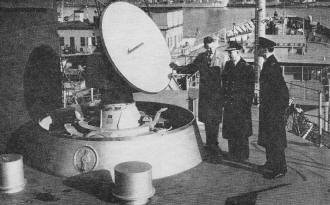|
May 1959 Electronics World
 Table of Contents
Table of Contents
Wax nostalgic about and learn from the history of early electronics. See articles
from
Electronics World, published May 1959
- December 1971. All copyrights hereby acknowledged.
|
According to Wikipedia, The Navy's
USS
Compass Island was one of two ships, the other being
USS Observation Island, converted and classified as navigational
research test vessels under the
Polaris Missile
system budget. As reported here, the newfangled radio sextant tracks the position of
the sun or moon to provide location accuracy much better than the best traditional compass.
Remember that in 1959 there was no satellite navigation, and in the middle of the ocean
land-based transmitters were useless as radio bearing references. Inertial navigation
systems could not hold their calibrations in the harsh physical environment of stormy
seas. This radio sextant system is fine as long as the sun and/or moon is high enough
in the sky to have antenna pointing access to one or the other, but there are times where
neither is available at nighttime because the moon and sun are in close angular proximity
in the sky (aka the new moon). The USS Compass Island was decommissioned in 1980.
Radio Sextant Tracks Moon

Control console aboard navigation ship.
New precision instrument aboard Navy experimental navigation ship has ten times the
accuracy of present marine compasses.
For the first time in history, the moon has been tracked continuously by radio through
the use of a new precision radio sextant designed and constructed by Collins Radio Company.
The new radio sextant has been delivered and installed aboard the Navy's experimental
navigation ship, the
USS "Compass Island,"
where it is used in navigation research. The unit is also used to track the sun and such
tracking is possible even under foul weather conditions. In addition, the sextant functions
as a precise compass, furnishing the direction of north with more than ten times the
accuracy of present marine compasses.
The instrument utilizes a 5-foot parabolic antenna connected to an extremely sensitive
radio receiver that measures the thermal radiation in the short microwave region. Operation
is at a wavelength of 1.8 centimeters (about 16,500 mc.). A new tracking system involving
advanced servo techniques is used. A special remote angle readout system, which can punch
its data directly on cards with great precision, is part of the installation. It is also
possible to control and check all phases of operation from a remote-control console.
From a mechanical standpoint, machining processes with tolerances as small as 25 millionths
of an inch were required, and new procedures for optical alignment were worked out. In
order to provide the necessary mechanical precision, an air conditioning and heating
system is used to maintain the equipment at a constant temperature at all times.

Antenna system of the AN/SRN-4 radio sextant installed on the USS
"Compass Island."
Aboard the USS "Compass Island," radio sextant observational data is coupled with
the vessel's precision time standard and presented directly to a navigational computer.
This then combines celestial and inertial data to determine the ship's location and true
north.
The sextant operates by picking up radiation from the moon or sun. Such radiation
fluctuates in the same fashion as the Johnson noise from a resistor, making detection
of the weak signal difficult. In this instrument, the antenna scans a circle around the
sun or moon's rim. If the antenna is pointed directly at the sun or moon, the received
signal will show no modulation at the scanning frequency, but if the antenna is displaced
slightly, the moon or sun signal will be modulated. Phase-sensitive detectors derive
error voltages which are used to make the radio sextant's antenna track the sun or moon.
The use of other heavenly bodies, such as radio stars, is presently very difficult
with practical size receiving equipment. These stars produce extremely weak radiation
in a much longer wavelength portion of the microwave region so that high resolving power
is difficult to achieve with reasonably compact equipment of the type described above.
Posted July 12, 2018
|









